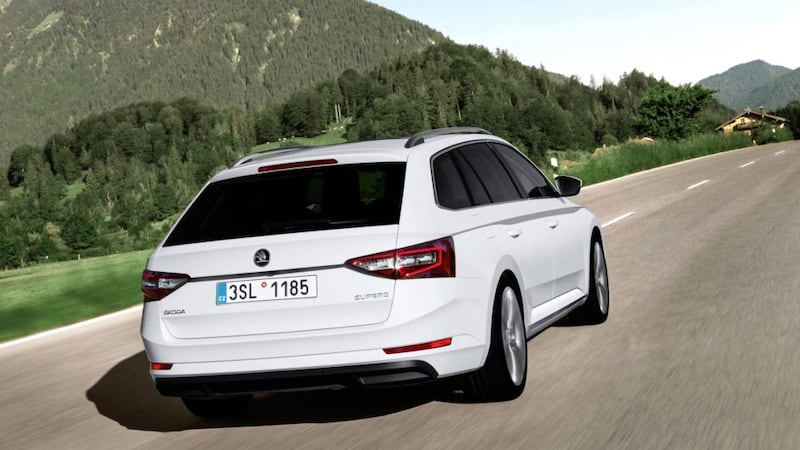Perhaps it's my half-English background but I do like a nice, big estate. Something you can really stretch your legs in, something that speaks of languid picnics amidst the trees or early morning airport sprints.
Posh estates are, of course, something of an English invention – an amalgam of those specially-bodied 1930s Rolls-Royces and Lagondas for picking up visiting guests from the station or for hauling your Labradors and over-and-under shotguns for a pleasant afternoon's wildlife massacre. Like I said, it must be in my blood.
Irish buyers generally regard estates as brewer reps' cars and just ignore them, but the Skoda Superb Combi seems to be able to sidestep that old prejudice. While most car makers struggle to hit the 10-per-cent-of-sales mark with estates, Skoda has been breezily selling Combis to just over a third of all Superb buyers since 2009. Perhaps Skoda buyers are less swayed by fashion. Or perhaps it was because the old Superb Combi also neatly sidestepped the lumpen styling of the old Superb saloon.


That won’t be a consideration for the new Superb – Skoda’s latest Big Boy is as slick-looking and handsome as any other big four-door, more so than some in fact, but there is to my eyes something ever so slightly more appealing again about the estate. Yes, there’s a faint hint of the smaller Seat Leon ST estate in the profile, but Skoda has once again carved handsomeness and desirability from a sensible package.
And boy is it sensible. The last Superb built a reputation on its cavernous interior, a reputation which was only partially fulfilled. Yes, it had lots of rear legroom but the old Superb was deceptively narrow, and was consequently saddled with a small fuel tank that hindered its touring range.
Flexibility
No such problems this time around – the new Superb Combi is based on the same Volkswagen MQB platform bits and pieces as the Passat, Golf, Octavia ad nauseam. The flexibility of the platform has allowed Skoda to make the car longer and wider, so cabin space is now utterly massive. Rear seat passengers can still extend their legs with ease, but now have somewhere to put their elbows, and it’s easier to squeeze a third person into the middle. Front seat occupants will simply stop thinking about such petty concerns as space – there’s so much of it, it won’t matter to them anymore, and that’s all in spite of a 62kg weight reduction compared to the old Superb.
The boot, always the crucial part of any estate, is – how can I put this? – ruddy massive: 660 litres in fact, dwarfing the carrying capacity of such as the BMW 5 Series or Audi A6. It also has a low 620mm loading lip and if you fold all the seats down (including the front passenger seat) you can carry up to 2,900-litres of whatever it is you're carrying, as well as loads breaking the three-metre mark.
Can you really consider the Superb as a rival to much more obviously ritzy cars as an Audi or BMW? Yes, you absolutely can. There is no difference in terms of quality in the cabin, or available optional equipment (cameras, automatic parking, big touch screens, wifi hotspots, you name it) and if it’s the A6 you’re specifically looking at, then the Skoda uses the same 150hp or 190hp 2.0-litre TDI engines to terrific effect.
With 150hp on board, the Superb is quiet, decently brisk and pleasant to drive without being overly engaging. Its steering is light and direct, and has reasonable levels of road-surface feedback but it’s not the kind of car you take for a Sunday morning thrash.
Rather, it's the sort of car you leave the house in and set out a day later in, perhaps, Sicily, wondering how you got there and why you're not tired. With Skoda's enviable reputation for high-quality engineering and a price tag starting at a hard under €30k, this is a car that could do some serious business in the big family car world. And take some VW Passat sales along with it. The only significant flaw we could find was that the optional DSG dual-clutch gearbox is not as good as once it was, making the Superb feel a touch reluctant to pick up pace from standstill and sometimes taking too long a pause before kicking down.
That, actually, is becoming something of an issue at Skoda and VW HQ. Skoda is riding high, making a 7 per cent profit margin on its cars and aiming to push sales to 1.5 million cars a year. VW, by contrast, sells many millions more but makes far less profit on each, around 2.5 per cent at the moment.
That’s a situation causing much vexation in VW’s boardroom and so former BMW exec Herbert Diess has been brought in to try and balance things out rather better. Skoda isn’t exactly going to be punished for doing well, but it’s business model will have to be changed to try and keep it from encroaching too far on VW’s patch.
Appeal
Certainly, it does seem jarringly odd that Skoda and VW would build two cars, from the same basic set of components and sell them to the same customers at similar price points. The Superb and the Passat are now going to be locked in mortal combat, vying to see who can bring in the higher numbers of private and business users, and there surely can’t be many left for whom the VW badge has that much more appeal than that of Skoda.
After all, if an aristocrat with a penchant for large estates knows anything, it’s how not to run down the inheritance too quickly.
The lowdown: Skoda Superb 2.0 TDI 150hp Style
Price: €40,095. Range starts at €28,995
Power: 150hp
Torque: 340Nm
0-100kmh: 8.9sec
Top speed: 218km/h
Claimed economy: 4.0l/100km (68mpg)
CO2 emissions: 106g/km
Motor tax: €190












